(*Yachtie phrase, meaning getting the mast up)
I had the following criteria
- It could be operated it single-handedly
- It could be locked off at any point in lowering or lifting the mast, to allow me to scurry about and untangle things*
- It could be folded up for storage
- It was safe
- It was cheap
(* This is inevitable when you consider the rigging's penchant for turning itself into a pile of knotted spaghetti whenever it is demounted)
Firstly, it is necessary to point out that the masts on trailer-sailers like mine, are designed to be lowered and raised. Mine has a pivot pin on the cabin roof, and is designed to be lowered backwards. Once the pivot pin is removed, the mast can be slid forward for transport-by-road. It seems likely that the designers of such systems believed that the typical boat-owner had a family of 7 ft weightlifters conveniently at hand for all such operations.OK, so that's an exaggeration, but getting the mast up or down is a challenge for me and a mate, and that presumes that I have a mate, and that he or she is available and willing to help.
The answer to my lack of mates, of course, is the mast-stepping contraption. This went through several iterations before I got something to work, which I have called Pole, Son of Pole and Twin Poles.
My first attempt was an early variation of a gin pole, using a long piece of timber. Let's call it Pre-Pole. A gin pole is a pole that is supported at one end and held at ninety degrees to the mast. The pole is supposed to be kept in this position by guide ropes secured on the deck. However, the wood in Pre-Pole split, and the mast collapsed onto the boat. Fortunately, my boat is strongly built, and didn't seem to mind, which surprised me almost as much as the mast falling down onto the stern of the boat.
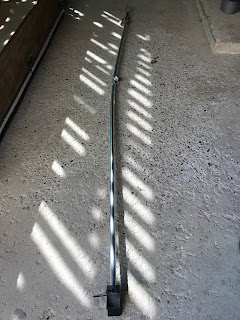 |
| Pole: 18mm aluminium tube with rubber vee-block foot, showing buckling in the middle |
Like its ancestor, Pole was a gin-pole, supported in the vertical position by guide-ropes on either side. The foot of Pole comprised a rubber vee-block, which, I had hoped, would grip the base of the mast. I drilled a 38mm hole into the rubber vee block to fit it to the end of Pole. The best way to drill a hole into a rubber block, I found, is with a spade drill, which is remarkably easy. The only hard part was sweeping up umpteen rubber shavings off the floor after the event.
If you're paying attention at this point, you might ask how I got a 40mm pole into a 38mm hole. The answer, of course, is that the hole is in a rubber block. One trick that worked well was to squeeze the rubber block in a vice. Drill the hole, release the vice, and the 38mm hole expands to 40mm. But, why not simply get a 40mm spade drill? Because the giant hardware store down the road didn't have anything bigger than 38mm.
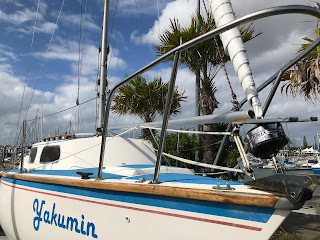 |
| Son of Pole before lowering the mast, showing the yoke at the bow for the furler |
Seeing that Pole was not beefy enough, I then tried Son of Pole. Son of Pole was a 30mm aluminium tube with 3mm thick walls, acquired from a metal merchant in the suburbs for about $30.
 |
| Son of Pole, with gin-pole upright and mast fully down. Note the guide-ropes either side, which should have kept Son of Pole upright. |
Now, I knew two things; the 40mm aluminium tube was beefy enough to avoid buckling, and I needed something to stop the mast slewing over to one side. I decided the most robust approach was an A-Frame, with two poles either side. Enter Twin Poles.
Twin Poles needed another trip to the metal merchant to buy another 40mm aluminium pole plus something to make the feet with. This delayed progress in weekly increments, as the only time I could get to the metal merchant was before 1100 on Saturday Morning, such were my working hours, and the metal merchant's opening hours. The same applied to the bolt shops, as I tried to source metric stainless steel bolts of the correct length, with or without shanks. The giant retail hardware store down the road does stock stainless steel bolts, but only in packs of three, or five, when you want four, and rarely of the right length or diameter.
 |
| Twin Poles: Foot assembly on the starboard side showing ply board slotted on to the base of a stanchion and a chain plate, pivot pin assembly and aluminium pole |
 |
| Twin Poles: Yoke Assembly part way through operation, showing line through block on the anchor plate to control the drop and lift |
Getting the angles right for the pivot pins was difficult. I pre-drilled the holes in the poles, then found corresponding points in the pivot-pin boxes. The pivot-pin boxes were fastened to the ply boards by a single bolt, which allowed some rotation between the pivot-pin boxes and boards. The rotation was needed to allow the boards to be slid into place. Some precision was needed to allow enough wiggle to allow the boards to be mounted and demounted, while getting the yoke to hold the forestay and furler in the right location.
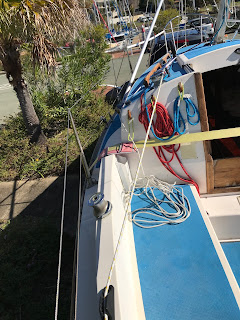 |
| Twin Poles; view from the stern showing the hauling line passing round the cabin top winch and secured on the port jam-cleat |
I secured the spinnaker halyard to an eye on the top of the yoke, which was bolted directly to a corresponding eye on the bottom. The hauling line was secured to the bottom eye. I thought that a direct fixing from one eye to the other would be more robust than something that relied on the plywood in the yoke. In the final assembly, the yoke had no bending moments, and the forces were transferred directly between the halyard fixing points, and straight down the axes of the poles. The structural engineering that I did in the early part of my career came in useful here, as I visualised how the forces would be transmitted through the assembly.
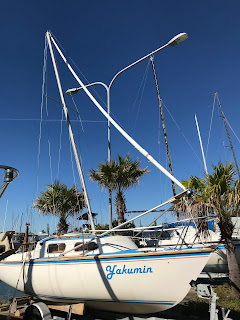 |
| Twin Poles: at the start of the drop |
Easing the hauling line allowed the mast to pivot back. This was a nervy moment for me and I jammed the hauling line a couple of times so that I could go forward and check that everything was secure, and to take photos. As in previous attempts, the mast wanted to slew off to starboard, but Twin Poles held firm.
With the mast fully down, the lever arm of the A-Frame became apparent. I had intended to make the lever arm as long as possible to reduce stress, but had it been any longer, I could not have un-hooked the furler, which was now almost 2m above the cabin roof. Having dropped the mast, I took out the mast pin and shifted the mast and furler forward to rest on the bracket on the bow rails. I then made the boat secure on its trailer and hauled it home, where I intended to do more tinkering.

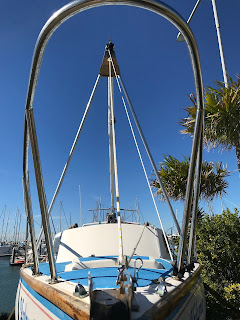




Recycled scrap steels and coppers are having higher demand in the market than the metals obtained from the mining industry. This is because, while doing the scrap copper recycling, the copper will not lose its original properties. Nearly 95 percent of the copper properties will be retained in the recycled scrap metals. And so, the business organizations are approaching the recyclers and avail the recycled scrap metals at the lower rates.
ReplyDeleteScrap Metal
Scrap Metal Recycling
Scrap Metal Prices
Thanks for sharing your experience. If you have waste material from your car and other vehicles or any other household scrap metal. Get in touch with Local Scrap Metal. We are interested to buy the Scrap Metal in Sydney
ReplyDelete